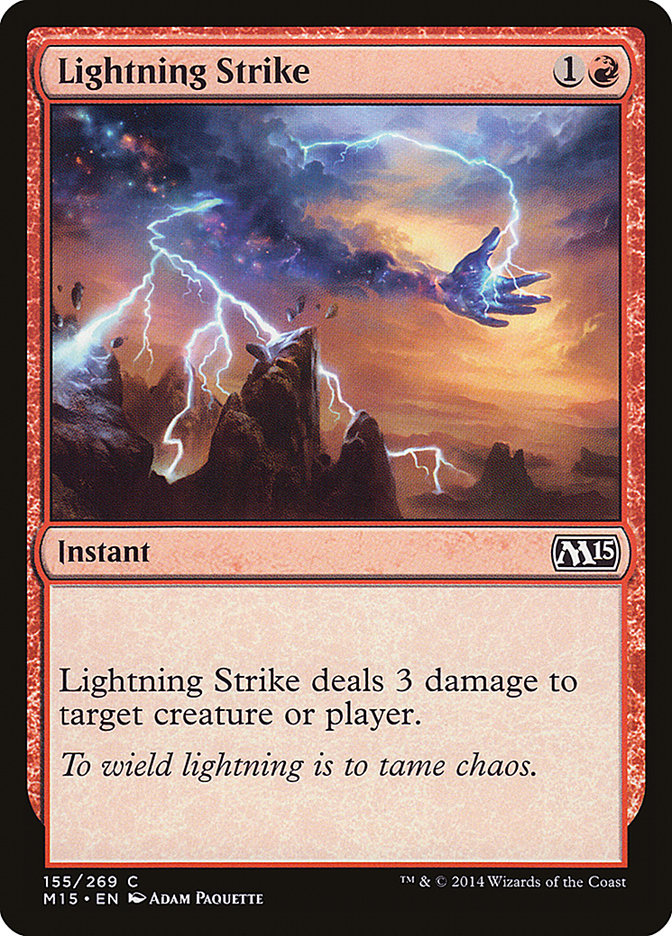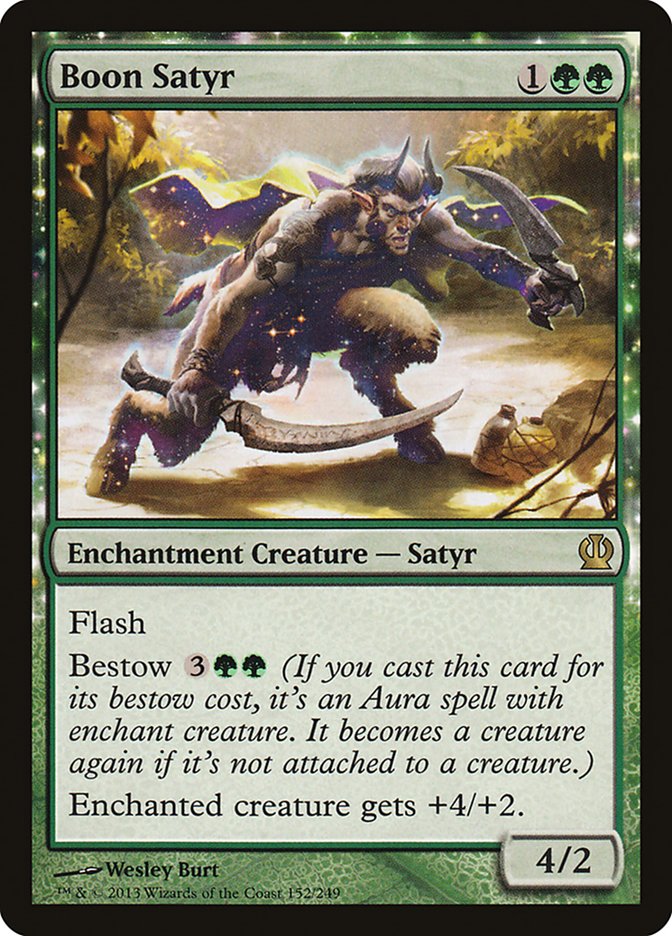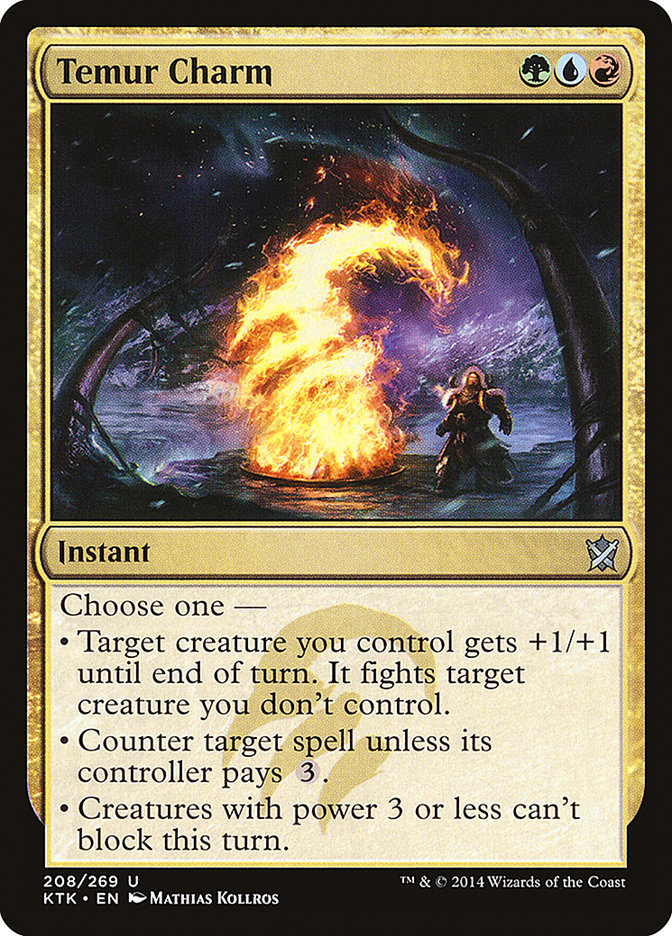This past weekend, I played in the Cardmageddon tournament in Las Vegas, sponsored by Cardagain. The event was an unusual experimental format that allowed
players to compete in single-elimination flights in a format of their choice on the first day to qualify for the second, which had a guaranteed prize pool
of $25,000. Whether it was the strange format or the competing events in Seattle and Baltimore that kept people away was unclear, but the turnout ended up
being very low, with less than fifty players making it through to the second day to compete.
Despite the poor turnout, the event organizers were upbeat and positive, and went so far as to offer free food to the players who did make the second day
when the concession stand closed down due to insufficient demand. While they certainly have some kinks to work out before their next event, it was great to
see a new company putting in the effort and taking the risk on running a big tournament.
Unsurprisingly, I chose to play Temur, using the more midrange Monster style build that I played in my last set of videos with the deck. After the World
Championships, I expected a rise in Abzan and Sultai Reanimator, as well as for many Jeskai players to switch to the Ascendancy tokens version rather than
the more traditional Mantis Rider plus burn plan.
That shift led me to reconsider the place of Lightning Strike in my deck. Early in the current Standard format, the ability to play the burn spell was one
of Temur’s big draws, since it matched up so well against all of the threats in the Jeskai deck that was everywhere back then. With Mantis Rider’s decline
though, Lightning Strike has gotten less and less attractive, especially in a world with so many Rhinos and Whips to get people out of burn range. It was
my most commonly sideboarded out card, and I found that in many matchups my game 1 win rate was negatively correlated to how many Lightning Strikes that I
drew.
This led me to move Lightning Strike to the sideboard, as well as cut down on the total number I ran in my 75. I replaced the extras with Arc Lightning, a
card that was already on my radar as a good removal spell against decks with Goblin Rabblemaster and Hordeling Outburst even before the Jeskai Tokens deck
that Yuuya played at worlds or the R/W token deck Sam Black used in the Standard portion of the Season Four Invitational became popular. Arc Lightning is
certainly less efficient than Lightning Strike, which is a big deal in matchups where speed is a priority like W/U Heroic, but it offers a lot of
flexibility in dealing with token strategies, or even just decks with a lot of small creatures like Mono-Red Aggro.
Because I expected more midrange and control decks in the field, I decided to play Xenagos in my maindeck. Xenagos is pretty much the polar opposite of
Lightning Strike. While Mantis Rider made Strike a premium removal spell, it pushed Xenagos out of the format almost entirely. With fewer hasty 3/3
creatures flying around, the Reveler is much better positioned to churn out satyrs and help create big turns.
Here’s the list I played:
Creatures (27)
- 4 Polukranos, World Eater
- 4 Sylvan Caryatid
- 4 Stormbreath Dragon
- 3 Courser of Kruphix
- 4 Rattleclaw Mystic
- 4 Savage Knuckleblade
- 4 Ashcloud Phoenix
Planeswalkers (3)
Lands (23)
Spells (7)

In the tournament, I faced pretty much the metagame I anticipated, facing one Jeskai Control deck, one G/B Constellation deck, one U/B Control deck, and
three (!) Abzan Reanimator decks. My overall record was not an impressive one, ending up an unexciting 3-3 after the event’s six rounds, with my losses
coming at the hands of Ben Lundquist, David Williams, and AJ Sacher in consecutive rounds. All of the losses felt close, coming down to a few points of
life or a key draw step in the deciding game, but there were some patterns in the losses that I noticed that felt like perhaps they might be able to be
fixed, as well as some general things I felt could be improved.
The first and most obvious was Boon Satyr, which really just underperformed all tournament. While Boon Satyr was a valuable asset in the more aggressive
version of Temur that I was playing earlier in the season, this build is much more focused on winning with creatures that are already big and don’t need
all that much help. I had thought that playing four copies of Crater’s Claws and three copies of Stubborn Denial in the deck would make me want lots of
cheap ways to trigger ferocious, but the reality is that you generally don’t care about countering much that you can’t just Force Spike when you don’t
already have a big monster in play, and the marginally increased value of Claws isn’t worth the cost of having an ultimately poorly-positioned creature in
your deck.
Boon Satyr gets brick walled by Siege Rhino, dies to Lightning Strike and Bile Blight – which are otherwise quite poor against your deck – and sets you up
to get blown out by Silence the Believers, which is a card that has begun to see more play for midrange mirror matches. While it may have had a place in
the Heir of the Wilds version of the deck, I think it’s time for me to give up the ghost and make the swap to Courser of Kruphix instead. Several of my
losses came in games in which I just flooded out, which is a situation that Courser can obviously help alleviate. With Crater’s Claws, Stormbreath Dragon,
and Polukranos, this is a deck that has a lot of uses for excess mana, but without Courser it doesn’t really have good card advantage tools, so you’re
stuck playing over thirty mana sources and drawing off the top of your deck.
I also found that I didn’t have any good ways to remove an opposing Siege Rhino against the Abzan Reanimator decks after sideboarding. Crater’s Claws is
pretty inefficient, and doesn’t match up well against anything else in their deck, so I tend to sideboard it out. While I think that strategy is generally
correct, it does mean that if an opponent is able to resolve a Rhino through my Disdainful Strokes, it’s generally on the table to stay. Both of my losses
to Abzan Reanimator involved my opponent playing multiple copies of Siege Rhino early and me just struggling to deal with them.
For what it’s worth, that’s exactly the reason that I think Abzan is the strongest version of the Whip of Erebos decks that are floating around these days.
While Sultai has better tools to fill its graveyard with Sidisi, and the G/B Constellation decks have a stronger long game thanks to Eidolon of Blossoms,
the Abzan versions are the best at just playing a normal game of Magic. Siege Rhino is one of the most powerful cards in the current Standard format, and
it can almost singlehandedly win games. You can still have the lategame power of cards like Whip of Erebos and Hornet Queen while playing Abzan, but you
also have the ability to just rumble with a 4/5 trampler that drains your opponent for three. In a world where people are expecting to run into
Constellation decks with Whip, there’s a lot to be said for having your best threat live through enchantment removal like Back to Nature or Reclamation
Sage.
In any case, my losses to Siege Rhino drove me to think about the best way to combat the Abzan Reanimator deck after sideboarding. I was already bringing
in Disdainful Stroke, which lines up well against a lot of their cards, and I had my Destructive Revelries to fight Courser, Whip, and whatever
Constellation package they may have. But I found myself wanting both a way to deal with a resolved Siege Rhino, as well as a way to get past a Hornet Queen
that snuck its way onto the board. I realized that there was one card that handily dealt with both.
I don’t like how Temur Charm fits with the general game flow of this version of Temur in the maindeck, which is why I’d moved away from it in the first
place. You’re spending all of your early turns tapping out for mana acceleration and then big creatures, and you’re not really in a position to hold up
three mana to stop something your opponent might play, especially against aggressive decks. Against Abzan Reanimator though, you can get value from the
Mana Leak mode even until late in the game thanks to expensive spells like Hornet Queen, and you can also use it to clear a resolved Rhino off the board
with a Stormbreath Dragon, Polukranos, or Ashcloud Phoenix. You can also always use the “creatures with power three or less can’t block” ability to force
your way past insect tokens, Coursers, and Caryatids that might be standing between you and a lethal attack. It’s a matchup where you really can use every
part of the buffalo.
I had previously been sideboarding Barrage of Boulders as a way to break stalemates that could also have utility against token decks, but with the move to
Arc Lightning, I think I can cut Barrage and just fit a couple of Temur Charms to give me more tools that can come in handy against Abzan Reanimator in
particular.
The rise in popularity of Whip decks, particularly those heavily leaning on Constellation synergies like Eidolon of Blossoms and Doomwake Giant, has also
led me to consider increasing the amount of enchantment hate in my sideboard. Destructive Revelry has been great, but Back to Nature is even more
devastating. The damage from Revelry is nice, and I like the fact that it can also hit Perilous Vault against U/B Control, since that’s a card they lean on
heavily to beat Ashcloud Phoenix. But Back to Nature is just backbreaking against a board of even just two enchantments, like Courser and Whip, to say
nothing of the situations when it can sweep up a Doomwake and Eidolon as well.
It’s important to be careful when you’re sideboarding and not bring in too many reactive cards, as well as not to bias your deck too heavily against one
element of your opponent’s deck and leave yourself vulnerable to another. This is again a big part of the reason I think Abzan is currently the leader of
the pack when it comes to the Whip decks. If people bring in Back to Nature and the like against you, Siege Rhino can still just trample all over their
face, and is all the more likely to do so if they have a bunch of enchantment removal spells in their hand instead of more flexible options.
My final takeaway from the event was that even in a field full of midrange and control decks where it ought to shine, Xenagos was something of a
disappointment. Siege Rhino and Courser of Kruphix were each a big part of what kept the Reveler and friends in check. The Rhino, in particular, made it
very difficult to protect Xenagos with Satyrs, and with so many high toughness creatures on the ground all the time, the tokens weren’t doing a whole lot
of attacking either. I did have a few nice turns where I was able to play multiple creatures off of the +1 ability, but overall I just wasn’t as happy with
Xenagos as I thought I would be. On the other hand, I did really like Sarkhan, which helped shore up the fact that the deck was a little lighter on removal
than before, so all was not lost in planeswalker-land.
With all of that in mind, this is the list I’m looking to try next:
Creatures (28)
- 4 Polukranos, World Eater
- 4 Sylvan Caryatid
- 4 Stormbreath Dragon
- 4 Courser of Kruphix
- 4 Rattleclaw Mystic
- 4 Savage Knuckleblade
- 4 Ashcloud Phoenix
Planeswalkers (2)
Lands (23)
Spells (7)

What do you think? Does Temur have what it takes to compete in Standard right now? Are there any cards I’m missing in this list?




